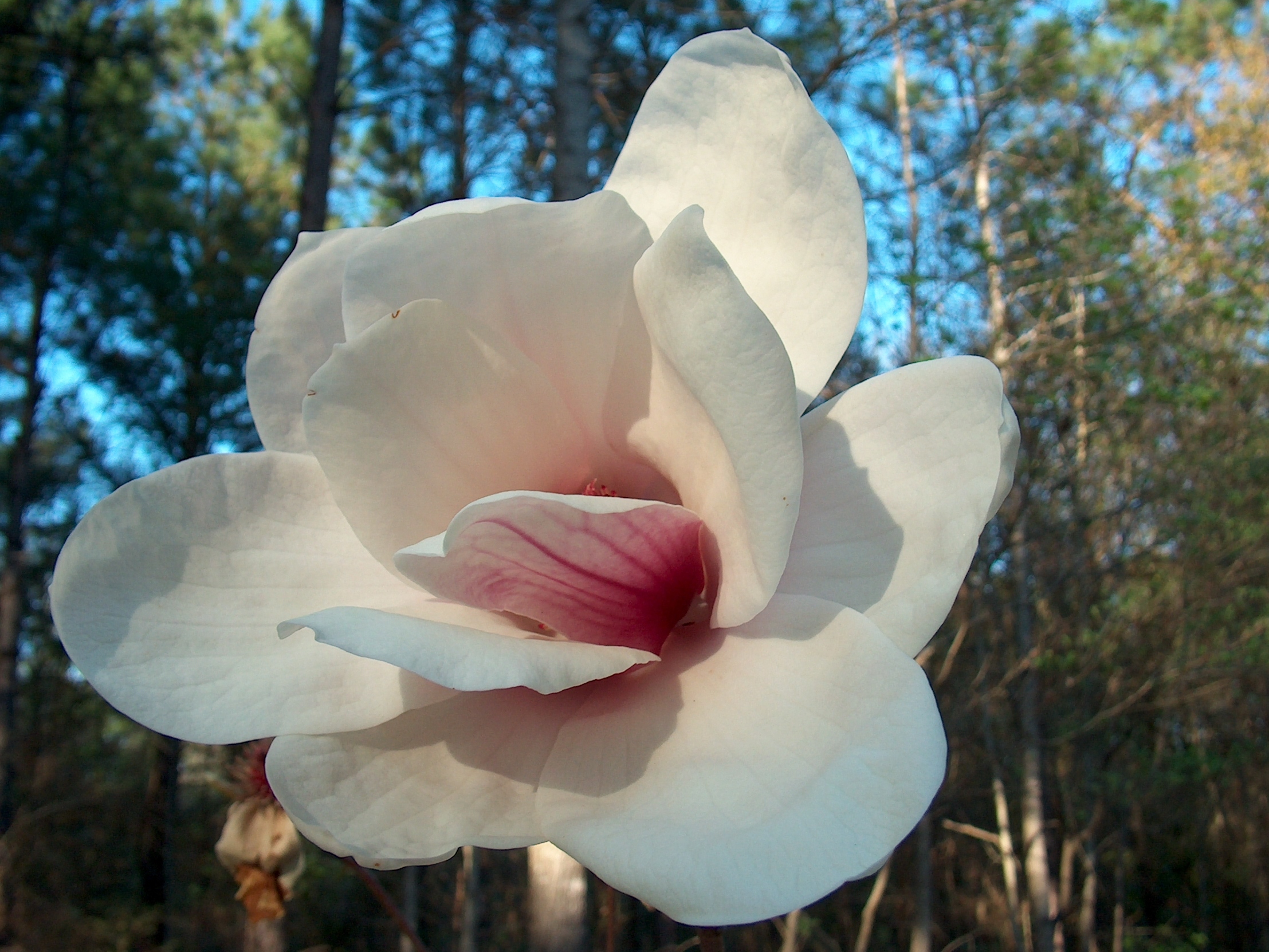
by Gary Knox | Feb 24, 2015
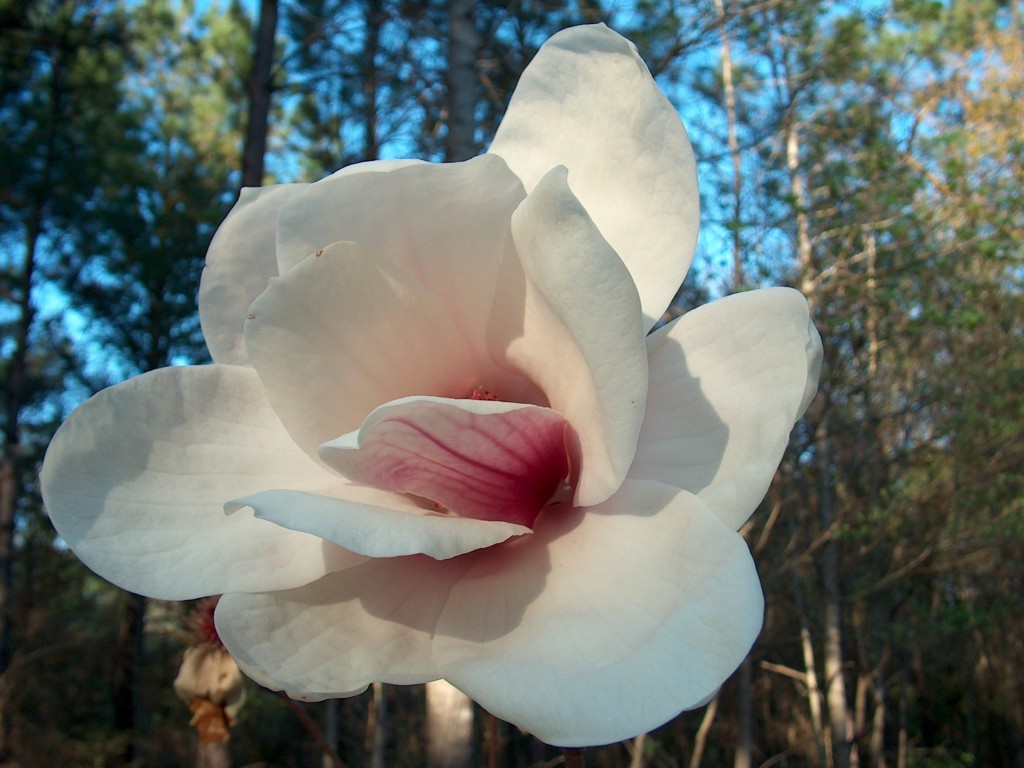
‘Jon Jon’ magnolia
This winter’s recurring freezes and frosts have played havoc with early flowering plants like magnolia. While buds are freeze-resistant, open magnolia flowers can quickly turn brown after exposure to temperatures about 30°F or lower. One way to avoid freeze-damaged flowers is to choose later blooming cultivars. These selections have flowers that open in north Florida during late February or later.
The Magnolia Garden at the University of Florida/IFAS North Florida Research and Education Center (NFREC) in Quincy has more than 150 types of magnolias planted. Based on over 10 years of data, five of the latest blooming magnolias are Daybreak, Jane, Betty, Jon Jon and Ann. These cultivars have peak bloom dates ranging from late February (Ann) to mid-March (Daybreak). Thus, they bloom after most flower-damaging freezes.
Daybreak has beautiful, large shell-pink flowers on a small tree. Jon Jon has huge white flowers with a streak of red-purple at the base. These fragrant flowers open goblet-shaped the first day, and then open wider to a cup-and-saucer shape on subsequent days. At NFREC, Daybreak and Jon Jon have about 6 weeks of flowers and grow as single-stem or multi-stem trees up to about 30 feet tall.
Jane, Betty and Ann are sister cultivars developed at the National Arboretum. As you would expect with sisters, they look-alike, and have a shrubby or multi-stemmed tree habit, generally growing about 15 feet tall and wide (much shorter and wider than Daybreak and Jon Jon). All three have upright, cup-shaped flowers in various shades of pink and red-purple. Betty has medium red-purple flowers that are the largest of the three, over 4 inches. Jane has 3- to 4-inch flowers that are medium pink outside and white or pale pink inside. Ann has the smallest flowers (3 inches) but they are also the darkest red-purple. As an added bonus, Ann boasts the ability to produce sporadic flowers all summer long! This results in Ann having an average of 13 weeks of flowers, as compared to Jane’s 10 weeks and Betty’s 8 weeks.
These five cultivars are generally available at garden centers during spring. Ann and Jane can be found at many “Big Box” stores. All five can be purchased at “good” independent garden centers and, as a last resort, from mail-order/Internet nurseries.
For more information about these and other magnolias, see Florida Extension publication, ‘Jon Jon’ Magnolia: A Late-Flowering Deciduous Magnolia for Northern Florida, and other magnolia publications here. Also, Magnolia Society International is a great resource with a very informative website. (Note the slide show below of Jon Jon, Ann, Betty, Daybreak and Jane.)
[portfolio_slideshow id=4059]
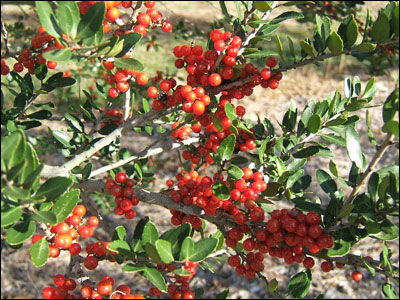
by Taylor Vandiver | Dec 16, 2014
Now that we’ve all been stuffed like a Thanksgiving turkey, it’s time to transition into the final and, arguably, most ornate holidays of the year. Right now you can hear your mantles and door frames crying out to be adorned. Your windows are begging for wreaths and giant red bows. And there may be a certain corner in your house that has been waiting all year for an evergreen, or two.
As we delve into the winter holidays our homes are being dressed to impress. There is nothing better than fresh foliage placed along a mantle or maybe a little mistletoe hanging from a previously unadorned beam. The scent of pine is in the air and I don’t know about you, but I’m ready to get decorating.
Here is a list of a few evergreen plants that make wonderful decorations for the season. You may even find some in your own backyard! Just make sure when you are removing foliage and fruit that you do it gently, so as not to harm the plant. Make all cuts at a 45 degree angle so that water will not pool on branch tips and rot. Also, if you forcefully remove foliage from a plant you could expose the susceptible cambium layer.

Wreaths and a decorated door frame add a bit of holiday cheer to this snowy scene. Photo courtesy Taylor Vandiver.
Traditional
Magnolia (Magnolia grandiflora) – This southern staple provides foliage that will liven up any banister or door frame. After being cut from the tree it can withstand the dryer temperatures indoors for days on end.
Hollies (Ilex spp.) – Hollies not only provide glossy green foliage, but bright red fruit that will beautifully adorn holiday arrangements and centerpieces.
Pine/Pinecones (Pinus spp.) – Pine trees offer a wispy presence to many decorations and their cones can give structure to wreaths and mantle pieces.
Boxwood (Buxus spp.) – Boxwoods are great for a touch of green.

Yaupon holly fruit and foliage. Photo courtesy UF/IFAS.
New Ideas
Abelia (Abelia x grandiflora) (evergreen to semi-evergreen) – Abelia are not commonly thought of when making holiday arrangements, but the texture of their foliage and the myriad of colors can spice up traditional decorations.
Aucuba (Aucuba japonica) – Aucuba offer a coarse texture that would pair well with the wispier pine foliage. Also, the gold dust variety will add a little more color to the mix.
Aspidistra (Aspidistra elatior) – Aspidistra foliage tends to feel more tropical. If you want to try a non-traditional arrangement these would work well and they can last for days provided a small amount of water.
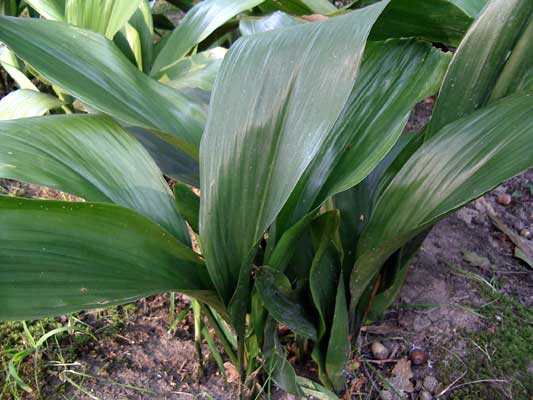
Aspidistra foliage that could easily be worked into a stunning arrangement.
Remember that a few well placed planters can liven up even the smallest spaces. Try using a small evergreen tree or shrub such as a magnolia, cypress / false cypress or arborvitae and surround them with poinsettia or pansies. You can try a smaller planter and add in pine cones, poinsettia, grasses, etc. Also if you are celebrating this holiday season with a live Christmas tree, then don’t be afraid to ask the grower/retail center for discarded branches. These can easily be formed into a wreath or used throughout the house. And since this is Florida there’s always the option of decorating your palm tree!
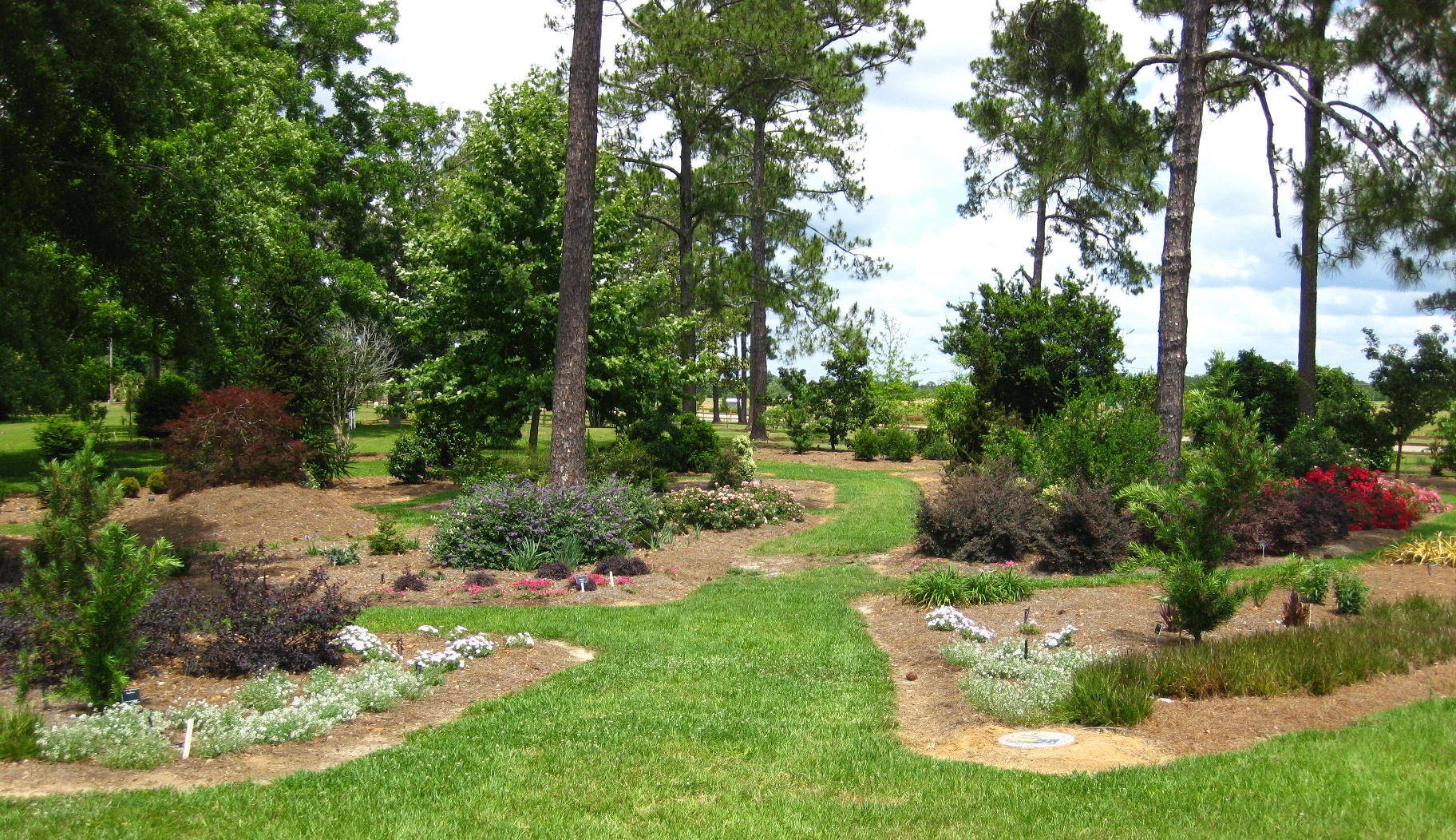
by Gary Knox | Nov 25, 2014

View of the Discovery Garden in Gardens of the Big Bend.

Weeping false butterflybush, Rostrinucula dependens, is a new and unusual perennial being evaluated in Gardens of the Big Bend.
Gardens of the Big Bend is a new botanical and teaching garden located on the grounds of the University of Florida/IFAS North Florida Research and Education Center in Quincy. The goals of these gardens are to evaluate new plants, promote garden plants adapted to the region, demonstrate environmentally sound principles of landscaping and provide a beautiful and educational environment for students, visitors, gardeners and Green Industry professionals.Located just 10 miles south of the Georgia-Florida border in Florida’s “Big Bend,” the Gardens are in USDA Cold Hardiness Zone 8b and have sandy-clay soils more typical of continental conditions than those of peninsular Florida.
Gardens of the Big Bend is a series of gardens, each with a theme or plant focus:
- The Discovery Garden contains over 170 species or cultivars of new, improved or underutilized trees, shrubs and perennials. The garden’s purpose is to help gardeners, landscapers and nursery growers “discover” new plants.
- The Magnolia Garden is part of the National Collection of Magnolia in recognition of its’ more than 200 species and cultivars, including some of the rarest magnolias in the world.
- The Crapemyrtle Garden includes six species and over 100 cultivars.
- Conifers can be found throughout the Gardens but are featured in the new “Jurassic” garden. More than just pines and junipers, the Gardens contain over 50 conifer species and cultivars, many of which are rare. In recognition, the American Conifer Society has designated the Gardens as a “Conifer Reference Garden”, the only one in Florida, and the southernmost in the U.S.
- The Dry Garden is the newest addition and contains about 140 different types of agave, aloe, cactus, dyckia, sedum, yucca, bulbs and other dry-adapted plants. It consists of a south-facing berm of boulders, gravel and sand about 160 feet long, 35 feet wide and 6 feet tall.
- Other gardens feature native, shade, Southern heritage, and weeping plants as well as collections of Japanese hydrangea and shrub roses. Additional gardens will be installed as time and funding permit.
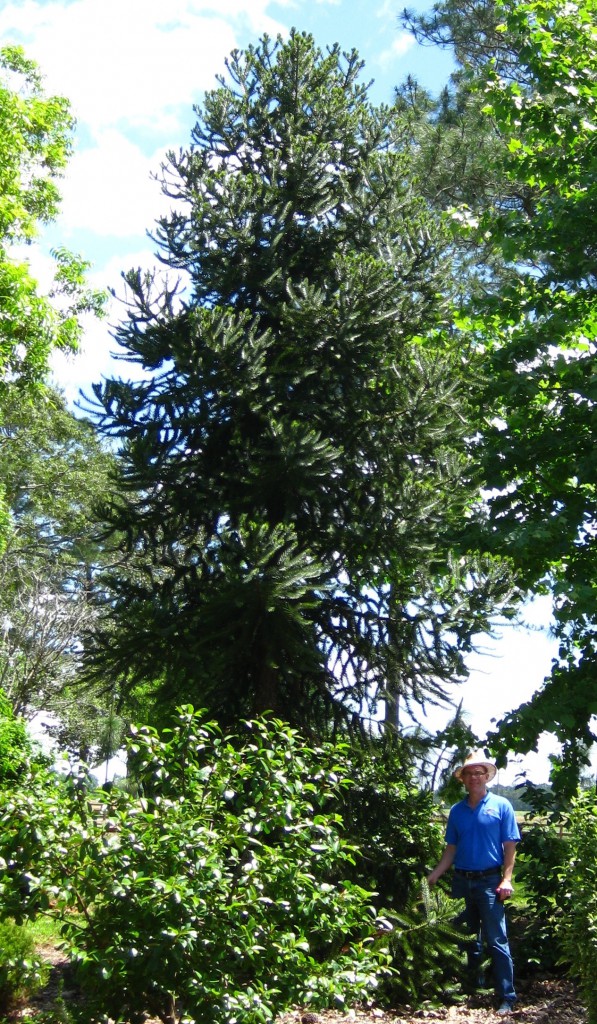
Parana pine, Araucaria angustifolia, is a rare type of conifer in the Gardens.
Gardens of the Big Bend formally began in 2008 thanks to the happy marriage of a new volunteer organization coupled with this University of Florida off-campus facility and plant collections I developed as part of research and extension projects. The volunteer organization, Gardening Friends of the Big Bend, Inc., formed in 2007 to support horticulture research and education. This group quickly seized on the idea of transplanting these existing plant collections into a series of gardens. Accordingly, its members hold fundraisers, provide volunteer labor and sponsor extension programs to raise awareness, provide funds and support garden development and maintenance.
Gardens of the Big Bend is located in Quincy at I-10 Exit 181, just 1/8 mile north on Pat Thomas Highway (SR 267). The gardens are free and open to the public during daylight hours year-round; professional staff are only available during normal business hours. To make a gift to the Gardens, please go to this website! Come visit us and watch the Gardens grow!
by Carrie Stevenson | Dec 9, 2013
How much is a 400-year old live oak tree worth? Can you buy one online, with free shipping, and charge it to the credit card? Pick one up at the local home improvement store? Ask Santa? Of course not. When admiring a tree that size, we have an innate sense of its value, but we would often have a hard time expressing it in dollars. How about a cluster of trees in a wooded lot? Are they worth more than the dollar store being built there? We are conditioned to appreciate the value of things because there’s a price tag on them. Unfortunately, natural phenomena do not have price tags, and many things that are “free” are often perceived to have no real value.
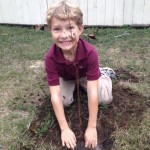
Planting a tree is an excellent way to insure clean air and water in the future. Photo credit: Carrie Stevenson
Trees, however, have value far beyond the price one might pay at a plant nursery. Their roots absorb polluted storm-water runoff, the primary cause of decreased water quality in Florida. Their leaves take in carbon dioxide and release the very oxygen we breathe. Providing homes for wildlife, fruit and nuts for human and animal consumption, compounds that form the basis of countless medications—trees provide innumerable benefits to ecosystems both local and worldwide. If a local government were to construct a facility or method that could filter the air and water at the same efficiency and volume of the trees in ones county, it would cost the community millions.
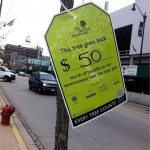
This street tree in Chicago was given a price tag to raise awareness of its value. Photo credit: Eric Stevenson
But how is is possible to capture these benefits in a way that we can relate to? Luckily, a partnership between arborists, engineers, and researchers with private industry, the US Forest Service, and the USDA has resulted in an excellent online tool called the National Tree Benefits calculator. Based on software called “i-Tree,” the calculator allows anyone to enter their zip code, choose from a list of common tree species, and using the diameter of a single tree, calculate its economic value. For example, a 15-inch live oak tree at the Escambia Extension office provides an annual benefit of $79 every year, increasing in value as it grows in girth and height. The website delves deeper into the tree’s value, placing storm-water uptake value at $23.77, electricity savings at $15.23, and the capability to remove 607 pounds of carbon dioxide from the atmosphere.
Extension Agents are currently working with youth in Escambia County to calculate these values for trees on their school campuses, local parks, and yards. When we’re finished, we will hang actual price tags on the trees showing their annual economic value to showcase these facts to residents of the community.
Interested in what kind of economic benefit that magnolia in the front yard is giving you? Check it out yourself at www.treebenefits.com, and let your neighbors know how valuable those trees can really be.
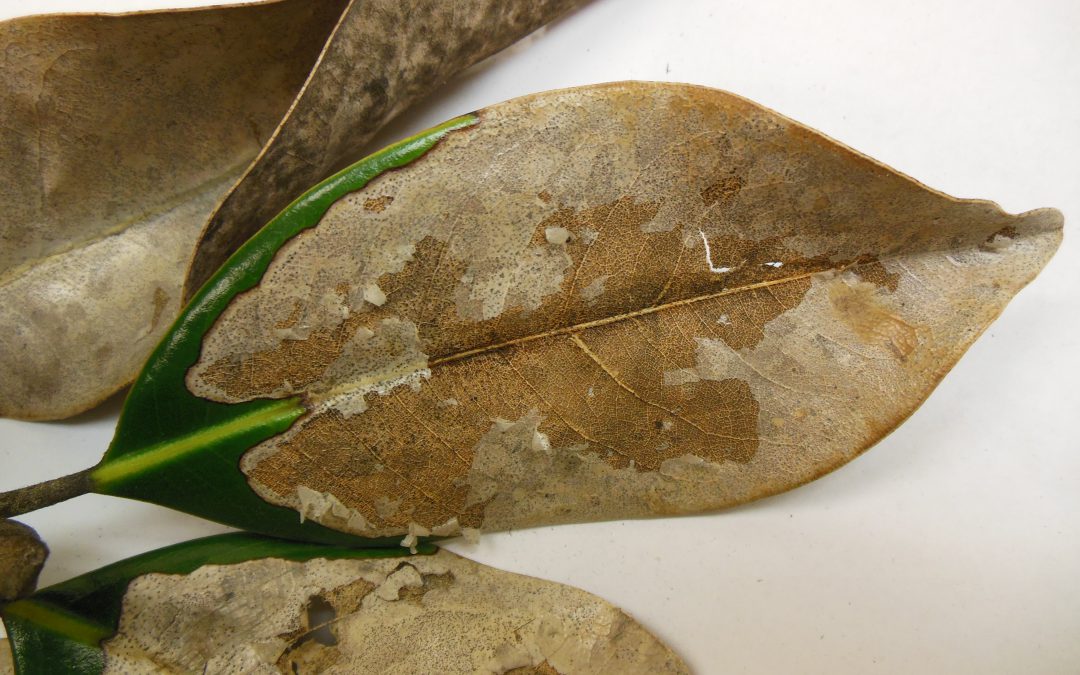
by Mary Salinas | Jun 21, 2013
We love our native magnolias in part because they are tough, easy to care for trees. The mainstay of southern gardens, they grace us with attractive thick, waxy leaves year round and sublimely fragrant and graceful blooms.
However, this past spring brought conditions that encouraged a fungal leaf disease known as anthracnose, most noticeably on the southern magnolia, Magnolia grandiflora. Affected leaves develop large irregular dead patches with a clearly defined border. The dead patches are a brownish gray and will flake and eventually deteriorate and fall away from the rest of the leaf. Fortunately it is rare for the disease to affect all branches of the tree and infection is somewhat spotty as you can in the photograph below.
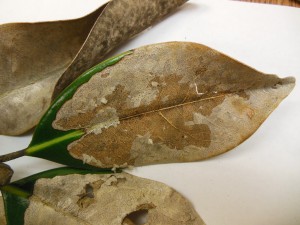
Credit: Mary Derrick, UF/IFAS Extension
Conditions that favor the development of anthracnose in magnolia are the cooler, moister conditions that the panhandle experienced this early spring. Spores overwinter on affected branches and in leaf litter and travel to their new hosts through rain, wind and splashing water.
View this article to learn more about the Southern Magnolia
[important]The good news is that this disease is rarely a serious threat to the long term health of the magnolia. [/important]

Credit: Mary Derrick, UF/IFAS Extension
But in order to avoid another infection next spring, remove and dispose of as many affected leaves as possible from the tree and certainly those that have fallen. Avoid irrigation that wets the leaves because the consistent presence of moisture on the leaf is a perfect incubator for anthracnose. Ensure that there is sufficient air flow around the trees. Fungicidal treatment is generally not warranted.













